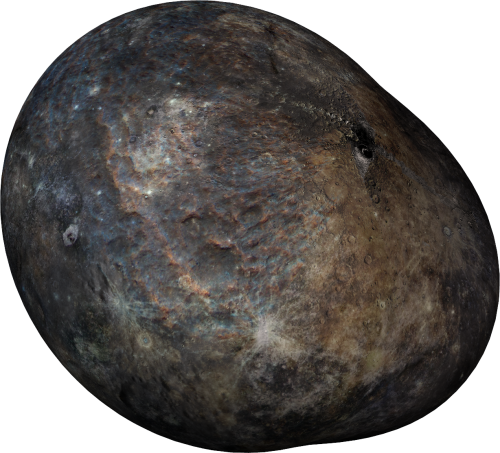
PLANET

CLASS C: CARBON
TYPE
Terrestrial
CORE
Iron or steel
MANTLE
Molten silicon carbide and titanium carbide
SURFACE
Graphite with diamond substrate; liquid hydrocarbons
ATMOSPHERE
If present, carbon dioxide and carbon monoxide; weather is possible on planets with an atmosphere and temperatures below 77° C
LIFE
Limited to microbial organisms
Class C: Carbon worlds are relatively rare terrestrial worlds, formed in star systems that take shape in a carbon-rich, oxygen-deficient protoplanetary disc. Like most other terrestrial planets, Class C: Carbon worlds have at their center a core rich in iron or steel, however, the surrounding mantle contains molten silicon carbide and titanium carbide. A thick layer of graphite forms the crust, and with sufficient pressure, a substratum of diamond many kilometers thick may exist. During volcanic eruptions, it is possible that great plumes of diamonds come to the surface, resulting in mountains of diamond and silicon carbide.
The surface of a Class C: Carbon world may have features similar to a classic terrestrial world, however any liquid on the surface would exist in the form of hydrocarbons such as tar or methane. If an atmosphere is present and temperatures are below 77° C, a weather cycle is possible, again with liquids in the form of tar or methane. Significant amounts of carbon smog would also be present.
Due to the lack of oxygen and water, Class C: Carbon worlds are not suitable for the development of complex organisms, however simple microbial life may form.
CLASS C1: PROTOPLANET

A protoplanet is a large planetary embryo developing within the protoplanetary disc of a young star system. Such bodies will have undergone some internal melting to produce a differentiated core. Over the span of many millions of years, protoplanets, will gain more matter through collisions with nearby bodies, and eventually attain a spherical shape.
In the case of a Class C protoplanet, this embryo would be rich in carbon.
CLASS C2: MOLTEN

A molten planet is typically a newly formed world with a crust that has yet to harden. These planets will typically cool and evolve into something more hospitable, though planets very close to a star may remain molten indefinitely due to tidal forces.
CLASS C3: PRIMORDIAL

A primordial world is a young planet that has cooled sufficiently for the crust to harden. The youngest primordial planets are barren and still rife with geologic activity; steam from volcanic eruptions condenses in the atmosphere and falls to the surface as liquid hydrocarbons, giving birth to the first shallow seas. Though uncommon on Class C planets, primitive bacteria may develop during this time.
CLASS C4: BARREN

While Class C planets can support an atmosphere, the vast majority of them do not. The result is a dead world with no atmosphere or geologic activity. Some planets are born into this classification. Others are failed worlds that become barren upon their demise.
CLASS C5: ARID

A mature carbon planet with an atmosphere; however precipitation in the form of liquid hydrocarbons is rare, and nominal amounts of liquid are present on the surface.
While many of these worlds are very hot and covered in a blanket of glittering sand, these conditions are not requisite for an arid classification. In fact, an arid world may be both cold and rocky.
CLASS C6: GLACIATED
A mature carbon planet with an atmosphere, where low temperatures have frozen the vast majority of liquid hydrocarbons on the surface.

CLASS C7: HOTHOUSE

A Class C planet with a thick atmosphere of carbon dioxide and carbon monoxide, resulting in a greenhouse effect that warms the planet considerably.
CLASS C8: TYPICAL
A Class C planet with an atmosphere that does not lean heavily toward any extreme surface or atmospheric conditions. These planets have a balance of dry land and liquid methane oceans, with an atmosphere that provides reasonable amounts of precipitation.

CLASS C9: PELAGIC

A Class C planet with an atmosphere that has large quantities of liquid hydrocarbons on the surface.
CLASS C10: OCEANIC

A Class C planet with an atmosphere and a surface that is completely covered with liquid hydrocarbons.
SUBCLASS CC: CHTHONIAN
A Chthonian planet is the metallic core of a gas giant that has spiraled inward from the cold zone of a star system and been stripped of its gaseous components. A Class C Chthonian world would simply be the carbon-rich core of a gas giant.
SUBCLASS CD: DWARF
Any Class C: Carbon world that does not meet the size requirements of a planet is considered a dwarf.
SUBCLASS CG: GIANT
A planet that exceeds the standard size of a Class C: Carbon world is considered a giant.
SUBCLASS CM: MOON
Any object that would otherwise be considered a Class C: Carbon world, but is a satellite orbiting another body is considered a moon.
SUBCLASS CR: ROGUE
A planet that has been ejected from its star system and is adrift in interstellar space.
SUBCLASS CX: IRRADIATED
A planet that is heavily irradiated by its parent star.



